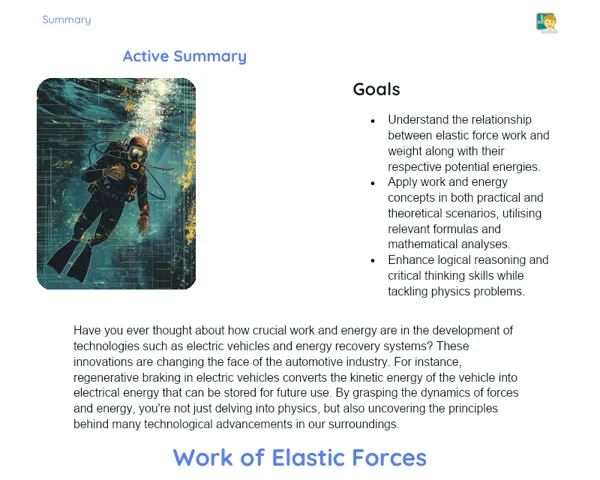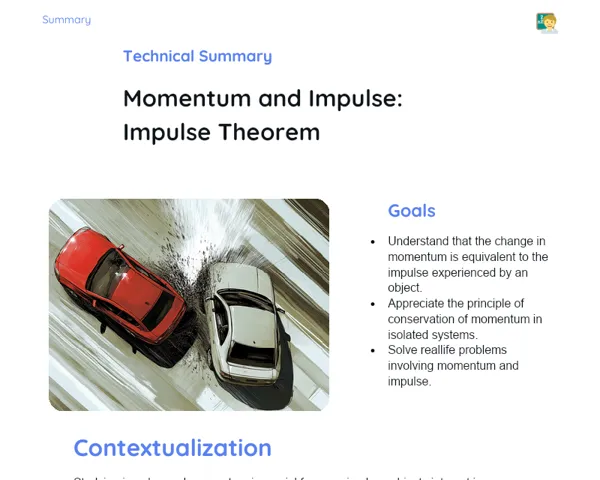Objectives
1. Differentiate clearly between static friction and kinetic friction, and understand the conditions under which each type operates.
2. Learn to calculate static and dynamic friction forces in real-life scenarios using the formula F=µN.
3. Encourage critical thinking among students by applying physics concepts to practical situations they encounter daily.
4. Promote teamwork through collaborative practical activities, enhancing peer learning.
Contextualization
Have you ever noticed how much harder it is to get a stationary object moving compared to keeping it in motion? This intriguing observation illustrates the significant role of friction in our daily lives and in the subject of physics. By grasping the concepts of static and kinetic friction, we not only enhance our theoretical understanding but also gain practical insights valuable in fields like engineering and design, where managing friction is vital for the smooth operation of machinery and tools. Engaging with these concepts allows you to explore one of the essential pillars of mechanics that underpins many of today’s technologies.
Important Topics
Static Friction
Static friction is the force that keeps an object at rest. To get it moving, you need to apply a force that exceeds the maximum static friction. This characteristic is crucial in various applications where precise movements are required, such as in manufacturing electronic parts or operating heavy machinery.
-
The static friction force acts in opposition to the applied force trying to set the object in motion.
-
The coefficient of static friction (µs) is a constant that relies on the surfaces in contact and is used to calculate the maximum static friction force.
-
Static friction plays a critical role in safety, as seen in braking systems, where the static friction must be adequate to halt a moving vehicle.
Kinetic Friction
Kinetic friction comes into play when an object is already in motion. This frictional force is slightly lower than the maximum static friction. The coefficient of kinetic friction (µk) is used to determine this force and is generally lesser than that of static friction. Understanding kinetic friction is essential for systems designed for continuous movement, such as trains or cargo handling systems.
-
Kinetic friction is vital for stabilizing motion and controlling speed in both machines and vehicles.
-
As the object remains in motion, the kinetic friction force remains relatively constant, making it easier to predict its impact on the system.
-
Minimizing kinetic friction is a goal across various engineering disciplines to enhance energy efficiency, reduce wear and tear, and prolong the lifespan of mechanical components.
Formula F=µN
The formula F=µN is key to calculating the friction force between two contacting objects. Here, 'F' stands for the friction force, 'µ' is the coefficient of friction between the surfaces, and 'N' represents the normal force, the perpendicular force exerted between the surfaces in contact. This equation allows us to quantify and anticipate frictional behavior in various scenarios, which is essential in both design and engineering.
-
This formula is applicable to both static and kinetic friction, adapting to different situations.
-
The coefficient of friction can vary significantly based on the surface conditions and materials involved, necessitating careful measurements in real applications.
-
A solid grasp of this formula and its application is crucial for success in numerous physics experiments and engineering tasks.
Key Terms
-
Static Friction: The resistance force that keeps an object at rest.
-
Kinetic Friction: The resistance force acting on an object in motion.
-
Coefficient of Friction (µ): A constant that defines the relationship between the friction force and normal force between two surfaces.
-
Normal Force (N): The perpendicular force applied by one surface on another when in contact.
For Reflection
-
How can a better understanding of static friction lead to improvements in everyday object designs, like furniture or gadgets?
-
Why is it crucial for engineers and designers to understand and manage friction coefficients in their projects?
-
In what ways can we apply the study of static and kinetic friction to enhance efficiency in transport systems or industrial machinery?
Important Conclusions
-
In this lesson, we examined the differences between static and kinetic friction, gaining insights into how these forces influence the movement of objects in our daily lives and various industrial applications.
-
We discussed the significance of understanding and calculating the coefficient of friction (µ) for different materials and situations, emphasizing its importance in fields like engineering and design.
-
Through using formulas like F=µN, we calculated static and kinetic friction, enabling us to predict and control the movement and stability of objects across different conditions.
To Exercise Knowledge
- Home Experiment: Use common household items such as books and different surfaces (like carpets, tiles, etc.) to test static and kinetic friction. Record your observations and calculate the coefficient of friction for each surface combination. 2. Friction Journal: For a week, keep a record of instances where friction is noticeable (for example, trying to open a tight jar lid). Reflect on the types of friction encountered and consider how you might apply your learning to improve those situations. 3. Research Assignment: Select a modern gadget (like a car, roller skates, or a smartphone) and investigate how friction considerations influenced its design. Prepare a report discussing how static and kinetic friction are optimized for effective functioning.
Challenge
🚀 Super-Slider Challenge: Create a 'super-slider'! Using recycled materials and experimenting with various types of 'wheels' (like old CDs, bottle caps, etc.), design an object that slides easily across different surfaces. Use your knowledge of friction to predict how well it will perform and test your predictions!
Study Tips
-
📚 Regular Reviews: Set aside time each week to revisit the concepts of static and dynamic friction. Consistent practice will reinforce your understanding.
-
💡 Utilize Online Resources: Explore visual and interactive online content that demonstrates friction in action, making abstract concepts more tangible.
-
👥 Join Study Groups: Collaborate with peers to discuss problems and practical applications related to friction. Working together can provide new insights and clear up uncertainties.



